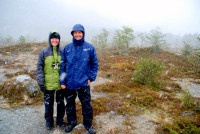Flights from Puerto Ordaz to Margarita Island (with a change of plane in Caracas) are straightforward – perhaps one of the few things that are in this country. During the layover in Caracas I try to exchange the Brazilian Reals I acquired in Santa Elena de Uarien for Venezuelan Bolivars, but no black market money changer wants them. And the official exchange rate is 1 Brazilian Real = 0.65 Venezuelan Bolivar- absolutely ridiculous (in Santa Elena the black market rate was 3 Venezuelan Bolivars for one Brazilian Real). In hindsight I should have converted all my Brazilian Reals in Santa Elena where the exchange rates were at their most competitive, but at that time Christi and I had no firm plans beyond the trip to Angel Falls and the last thing I wanted was to leave Venezuela with a wallet bulging with useless Bolivars. Reluctantly I retrieve a stash of US$ (US$580 to be exact) from the security pouch (wrapped around my stomach beneath my shirt) and line up at an official exchange booth to buy the dreaded Bolivars. This time, though, the black market money changers are literally falling over themselves to get hold of my dollars and I’m quickly spirited away to a secluded nook where a rather nervous and furtive transaction takes place. The black market rate is 5:1, whereas the official government sanctioned rate is 1:1. How does the Venezuelan economy survive?
While we languished in Puerto Ordaz airport yesterday, Kelvin somehow made friends with the owner of the Hard Rock cafe on Margarita Island. The guy assured us that his staff would help us find accommodation. Once we land at the grandly named Santiago Marino Caribbean International Airport on Margarita Island, therefore, we taxi to the café with high expectations. But of course none of the staff are expecting us. And they certainly don’t have a list of fancy rooms at backpacker prices for this the busiest season of the year on the most popular island destination in the Venezuelan Caribbean.
It is actually quite remarkable that Christi and I have stood on the most southerly point of the South American continent and now we are about as far north as you can get in South America – a distance of some 4,500 miles as the crow flies (and a lot further the way we did it!). By the way, the most northerly point on the mainland of South America is, technically, Punta Gallinas in Colombia.
Anyway, back to our predicament at the Hard Rock Cafe. While the staff have no hard intel on accommodation on the island they do have a few leads and they let us use the boss’s phone (thanks boss!). Kelvin and Christi then take it in turns to cold call the potential leads, until against all odds, they find something in Playa El Agua. We don’t really know where we are going or what we can expect when we get there, but we say thank you to the staff at the Hard Rock Cafe, jump into yet another taxi, and head for a beach on the north-east tip of the island. Our chalet, a couple of blocks back from the street, comprises two bedrooms, a kitchen, and a bathroom for 300B per night (which is either US$60 per night orUS$300 per night depending on the exchange rate you use – and let me tell you this ain’t no US$300 per night luxury suite). The chalet does come with abundant and quite vicious mosquitoes, however. I hate these things and spend hours killing those that call our bedroom home before they can feast on my tasty white flesh. If you recall I already gave a pint of blood in Estero del Ibera, Argentina, and I don’t plan on giving another pint any time soon.
Blog post by Roderick Phillips, author of Weary Heart – a gut-wrenching, heart-wrenching, laugh-wrenching story.




Speak Your Mind